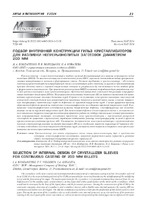| dc.contributor.author | Бондаренко, И. А. | ru |
| dc.contributor.author | Володькин, П. В. | ru |
| dc.contributor.author | Ковалева, И. А. | ru |
| dc.coverage.spatial | Минск | ru |
| dc.date.accessioned | 2024-09-18T07:09:48Z | |
| dc.date.available | 2024-09-18T07:09:48Z | |
| dc.date.issued | 2024 | |
| dc.identifier.citation | Бондаренко, И. А. Подбор внутренней конструкции гильз кристаллизаторов для разливки непрерывно‑литых заготовок диаметром 200 мм = Selection of internal design of crystallizer sleeves for continuous casting of 200 mm billets / И. А. Бондаренко, П. В. Володькин, И. А. Ковалева // Литье и металлургия. – 2024. – № 3. – С. 23-28. | ru |
| dc.identifier.uri | https://rep.bntu.by/handle/data/149622 | |
| dc.description.abstract | Кристаллизатор – самый ответственный и наиболее важный функциональный узел машины непрерывного литья
заготовок (МНЛЗ). Он является основным технологическим узлом MHЛ3, агрегатом для отвода теплоты при кристаллизации затвердевающего металла и формировании слитка. Основное требование к кристаллизатору – обеспечить
максимальный теплоотвод от затвердевающей стали к охлаждающей воде и получить на выходе из кристаллизатора
прочную оболочку слитка с хорошей поверхностью, которая не разрушалась бы под действием тепла жидкой фазы
и ферростатического давления. При проведении реконструкции МНЛЗ компанией-подрядчиком
были разработаны чертежи кристаллизаторов и гильз кристаллизаторов с двухконусной внутренней геометрией для разливки непрерывно‑литых заготовок диаметром 200 мм. Непрерывнолитая заготовка диаметром 200 мм является заготовкой для производства горячекатаных стальных бесшовных труб. В процессе эксплуатации гильз кристаллизаторов с двухконусной
внутренней геометрией отмечали ускоренный износ защитного покрытия в нижней части гильзы, а также повышенную отсортировку горячекатаных труб по дефектам на наружной поверхности труб. С целью выявления причины
образования дефектов проведены комплексные металлографические исследования наружной поверхности труб. В результате металлографического исследования выявлены поверхностные дефекты, классифицируемые как сталеплавильные плены на наружной поверхности труб. Для минимизации дефекта «сталеплавильная плена» и уменьшения износа защитного покрытия гильз кристаллизаторов проведена работа по подбору оптимальных условий кристаллизации непрерывнолитой заготовки: исследовано применение гильз кристаллизаторов с трехконусной внутренней
геометрией по сравнению с двухконусной; опробовано поддержание разницы температуры воды на вход и выход из
кристаллизатора в заданных пределах (ΔT). Установлено, что применение гильз кристаллизатора с трехконусной внутренней геометрией при разливке заготовки диаметром 200 мм и стабильное поведение параметра ΔT позволило обеспечить необходимое качество поверхности бесшовных труб, уменьшить износ защитного покрытия гильз кристаллизаторов и увеличить производительность МНЛЗ. | ru |
| dc.language.iso | ru | ru |
| dc.publisher | БНТУ | ru |
| dc.title | Подбор внутренней конструкции гильз кристаллизаторов для разливки непрерывно‑литых заготовок диаметром 200 мм | ru |
| dc.title.alternative | Selection of internal design of crystallizer sleeves for continuous casting of 200 mm billets | ru |
| dc.type | Article | ru |
| dc.identifier.doi | 10.21122/1683-6065-2024-2-23-28 | |
| local.description.annotation | The crystallizer is the most critical and most important functional unit of a continuous casting machine (hereinafter referred
to as CCM). It is the main technological unit of the CCM, an assembly for removing heat during the solidification of the solidifying
metal and the formation of the ingot. The main requirement for the crystallizer is to provide maximum heat removal from the solidifying
steel to the cooling water, and to obtain a strong ingot shell with a good surface at the outlet of the crystallizer, which
would not be destroyed by the heat of the liquid phase and the ferrostatic pressure. During the reconstruction of the CCM by the
contractor company, drawings of crystallizers and crystallizer sleeves with a double-cone internal geometry for casting 200 mm
continuous cast billets were developed. The 200 mm continuous cast billet is a billet for the production of hot-rolled seamless steel
pipes. During the operation of the crystallizer sleeves with a double-cone internal geometry, an accelerated wear of the protective
coating in the lower part of the sleeve was noted, as well as an increased rejection of hot-rolled pipes due to defects on the outer surface of the pipes. In order to identify the cause of the defect formation, complex metallographic studies of the outer surface of
the pipes were carried out. As a result of the metallographic study, surface defects classified as steel mill scale on the outer surface
of the pipes were identified. To minimize the “steel mill scale” defect and reduce the wear of the protective coating of the
crystallizer sleeves, work was carried out to select the optimal conditions for the crystallization of the continuous cast billet: the
use of crystallizer sleeves with a three-cone internal geometry compared to a double-cone was investigated; maintaining the temperature
difference of the water at the inlet and outlet of the crystallizer within specified limits (ΔT) was tested. It was found that
the use of a crystallizer sleeve with a three-cone internal geometry for casting 200 mm billets and the stable behavior of the ΔT
parameter made it possible to ensure the required quality of the surface of seamless pipes, reduce the wear of the protective coating
of the crystallizer sleeves and increase the productivity of the CCM. | ru |

